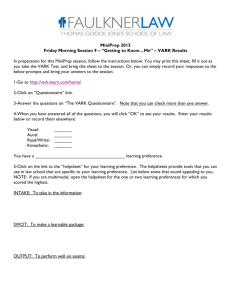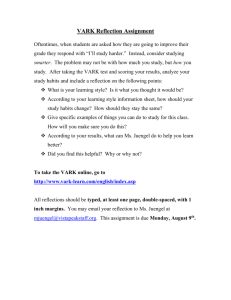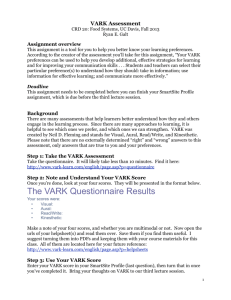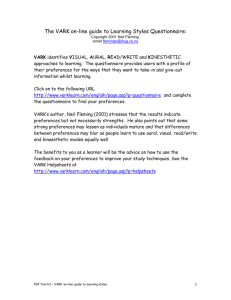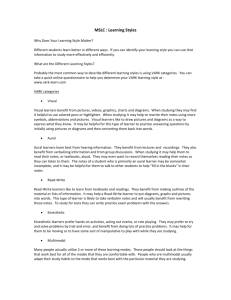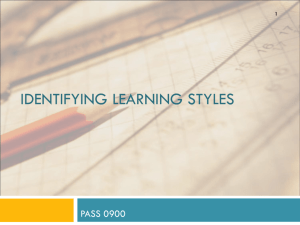File
advertisement
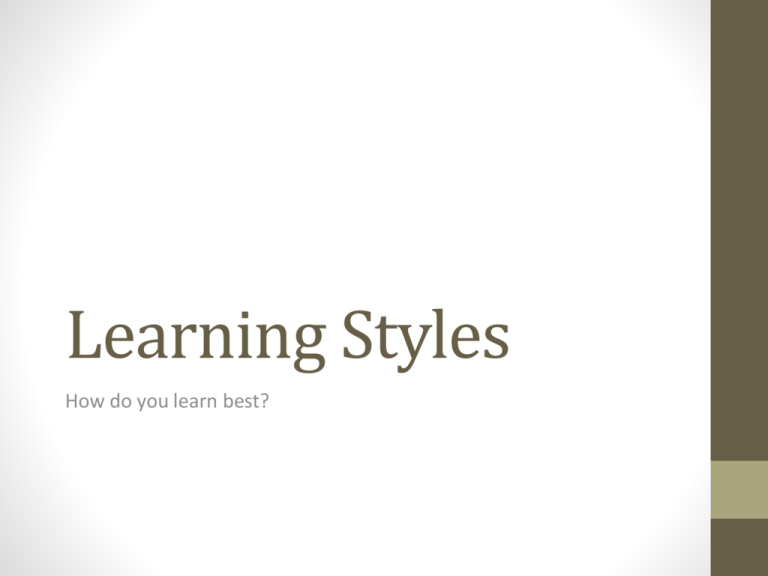
Learning Styles How do you learn best? Let’s make a paper crane to see which way you learn best! Making a Paper Crane http://www.origami-fun.com/origami-crane.html VISUAL Hand out Instructions READ/WRITE Listen to Video (No image) https://www.youtube.com/watch?v=FyC7pkT-dE0 AUDITORY Kinesthetic… (We are kind of doing that so…. ) Let’s Try a Combination! • https://www.youtube.com/watch?v=FyC7pkT-dE0 • This is Auditory and Visual, as well as Kinesthetic ! How do you learn? • VARK MODEL VARK Model Visual (V): • This preference includes the depiction of information in such things as maps, spider diagrams, charts, graphs, flow charts, labelled diagrams, and all the symbolic arrows, circles, hierarchies and other devices, that people use to represent what could have been presented in words. VARK Model Aural / Auditory (A): • A preference for information that is “heard or spoken.” • Aural learners report that they learn best from lectures, group discussion, radio, email, using mobile phones, speaking, webchat and talking things through. • Includes talking out loud, as well as talking to oneself. • Often they want to sort things out by speaking first, rather than sorting out their ideas and then speaking. • They have a need to say it themselves and they learn through saying it – their way. VARK Model Read/write (R): • This preference is for information displayed as words. Not surprisingly, many teachers and students have a strong preference for this mode. • Being able to write well and read widely are attributes sought by employers of graduates. This preference emphasizes textbased input and output – reading and writing in all its forms (reports, essays and assignments). • People who prefer this modality are often addicted to PowerPoint, the Internet, lists, diaries, dictionaries, thesauri, quotations and words, words, words… VARK Model Kinesthetic (K): • By definition, the “perceptual preference related to the use of experience and practice (simulated or real).” • The key is that people who prefer this mode are connected directly, “either through concrete personal experiences, examples, practice or simulation” • It includes demonstrations, simulations, videos and movies of “real” things, as well as case studies, practice and applications. • The key is the reality or concrete nature of the example. If it can be grasped, held, tasted, or felt it will probably be included. VARK Model • What about Mixtures? Multimodality (MM): • Life is multimodal. There are seldom instances where one mode is used, or is sufficient, so that is why there is a fourpart VARK profile. • Many of us do best with a combination! Do people actually use this? • Who cares? Do people actually use this? Why? YES PEOPLE USE THIS! • Individuals, schools, universities etc. etc. all benefit from discovering how they learn best and using their preference modes! • In the past year over 500,000 people have used the VARK test to see how they learn!! Do you know how you learn? • VARK tells you something about yourself • It can be used to understand your boss, your friends, your parents, your boyfriend/girlfriend, your teacher, your relatives, and yourself! • It has helped people understand each other and assists them to learn more effectively in many situations. • TAKE THE VARK TEST- Together (You will get an answer sheet for the questions to follow…) Looking at the Results • The results indicate a ‘rule of thumb’ and should not be rigidly applied. • Remember that the questionnaire is not intended to ‘box’ respondents into a mindset that they have been ‘diagnosed’. Rather, it is designed to initiate discussion about, and reflection upon, learning preferences. • It is not expected that any one preference will be dominant or that all participants will be multimodal. • The most consistent finding from VARK questionnaire results is that our classrooms are very diverse. • Pay particular attention to zero scores. Zero scores in a profile are unusual and the person will often have an interesting story to tell. (Anyone with Zero scores want to share their story?) • Emphasize that the results indicate preferences not strengths in whatever way you can! Once you have your results… • Once you know how you learn best, the VARK model has some strategies for you! • Really consider this as EXAMS are looming, and you could pick up a tip or two! Avoid this in exams…… Visual Strategies INTAKE • lecturers who use gestures and picturesque language • pictures, videos, posters, slides • flowcharts • underlining, different colours, highlighters • textbooks with diagrams and pictures • graphs • symbols HOW TO STUDY • Use all or most of the techniques listed • Reconstruct the images in different ways… try different spatial arrangements. • Redraw your pages from memory • Replace words with symbols or initials OUTPUT To perform well in any test, assignment or examination: • Draw things, use diagrams • Write exam answers • Recall the pictures made by your pages • Turning your visuals back into words Aural Strategies INTAKE • attend classes • attend discussions and tutorials • discuss topics with others • discuss topics with your teachers • explain new ideas to other people • use a tape recorder • remember the interesting examples, stories, jokes… • describe the overheads, pictures and other visuals to somebody who was not there • leave spaces in your notes for later recall and ‘filling’ HOW TO STUDY • Speak your answers aloud or inside your head. • Put your summarized notes onto tapes and listen to them. • Ask others to ‘hear’ your understanding of a topic. • Read your summarized notes aloud. • Explain your notes to another ‘aural’ person. OUTPUT To perform well in any test, assignment or examination: • Imagine talking with the examiner. • Listen to your voices and write them down. • Spend time in quiet places recalling the ideas. • Practice writing answers to old exam questions. Read/Write Strategies INTAKE • lists • headings • dictionaries • glossaries • definitions • handouts • textbooks • readings – library • notes (often verbatim) • teachers who use words well and have lots of information in sentences and notes • essays • manuals (computing and laboratory) HOW TO STUDY : • Write out the words again and again. • Read your notes (silently) again and again. • Rewrite the ideas and principles into other words. • Organize any diagrams, graphs … into statements, e.g. “The trend is…” • Turn reactions, actions, diagrams, charts and flows into words. • Imagine your lists arranged in multiple choice questions and distinguish each from each. OUTPUT To perform well in any test, assignment or examination: • • • • • Write exam answers. Practice with multiple choice questions. Write paragraphs, beginnings and endings. Write your lists (a,b,c,d,1,2,3,4). Arrange your words into hierarchies and points. Kinesthetic Strategies INTAKE • all your senses – sight, touch, taste, smell, hearing • laboratories • field trips • field tours • examples of principles • lecturers who give real-life examples • applications • hands-on approaches (computing) • trial and error • collections of rock types, plants, shells, grasses… • exhibits, samples, photographs… • recipes – solutions to problems, previous exam papers HOW TO STUDY • Your lecture notes may be poor because the topics were not ‘concrete’ or ‘relevant’. • You will remember the “real” things that happened. • Put plenty of examples into your summary. Use case studies and applications to help with principles and abstract concepts. • Talk about your notes with another “K” person. • Use pictures and photographs that illustrate an idea. • Go back to the laboratory or your lab manual. • Recall the experiments, field trip… OUTPUT • To perform well in any test, assignment or examination: • Write practice answers, paragraphs… • Role play the exam situation in your own room. Get ready to study. Hopefully you have a better idea of how you learn and have some tips that may help you study! Also, here is a great video for test motivation! As I think you may need some right now (Note: it is highly dramatic but speaks great truth!!) Example: When you are in school are thinking about the opportunity presented to you, or the obligation….?? Change how you see this challenge! Stop being average…you are better than average!! • https://www.youtube.com/watch?v=H5n1aP0i6aQ Also… mind the random ‘male weight gain ad…. Sorry :/ • Focus on the motivation to study and do amazing! Note: • Wednesday and Thursday you will be working on your SelfDirected Group Project • There will be a quick review on Thursday (4 types of learning (Classical, Operant, Social), Intelligence, IQ, Creativity and the VARK model) • There will be a QUIZ Friday
